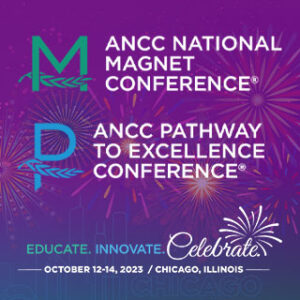
November 2023
Expect More!
Healthcare is changing rapidly, and pressures on nursing are increasing, making it critical that you  optimize your nursing excellence investment.
optimize your nursing excellence investment.
To do so, your journey to excellence must be transformational. Expect more than a banner on the wall from achieving Magnet or Pathway to Excellence designation. You must develop a culture of excellence and ensure your nursing excellence structures produce real outcomes for your nursing team.
Are your nurses satisfied and highly engaged? Are your nurse retention rates steadily improving? Do your nurse leaders have the time to find joy and meaning in their work?
To support you, we are evolving our nursing excellence services to better meet today’s needs and to help create the transformational nurse leaders needed to direct change and elevate nursing.
We will continue to be the best in the world at helping you navigate to successful designation. But we have also invested more than $1 million in staff, process changes, program development and workshop redevelopment in the last year alone as part of our commitment to continuous excellence. Our team has the experience and capabilities to help you establish a culture of transformational leadership, build skilled nursing leadership teams, and create nursing work environments that enable your nursing teams to deliver the best possible patient care.
We are always working to best meet your needs. You can expect more from Tipton Health!
We do rely on your feedback to improve. Please tell me how we can better meet your challenges and support your mission. I am available at your convenience at dan@tiptonhealth.com.
Learnings from the 2023 Magnet® Conference
 As usual, this year’s Magnet Conference was an exciting time to make connections, learn new things, and share well-earned and exciting successes. We especially enjoyed seeing our clients, providing new information, and celebrating those who have both achieved their designations and who are well on their way toward Magnet success.
As usual, this year’s Magnet Conference was an exciting time to make connections, learn new things, and share well-earned and exciting successes. We especially enjoyed seeing our clients, providing new information, and celebrating those who have both achieved their designations and who are well on their way toward Magnet success.
Since returning from the 2023 Magnet Conference, our teams have been hard at work refining our coaching practices. While there were no major changes or clarifications to the 2023 Magnet Application Manual announced, aside from some information about using composite scores in Fab 5 data, we did hear many questions from clients and others about best practices for writing Magnet documents.
We are currently working to clarify the ANCC’s expectations for reporting composite scores in your Fab 5 documents, and for now, we have compiled our guidance on best practices for writing Magnet exemplars to address common questions.
Before writing any Magnet document, ensure that your story will meet the criteria by determining the “main character” and the key elements of the example. For example, determine whether the “main character” should be a clinical nurse or the CNO, and then evaluate your story to determine whether the main character took the required steps or achieved an appropriate outcome for the example. Use the criteria as a checklist to guide your selection and writing of stories.
Once you have a story, we need to get right to the point with each example. Provide only the strictly necessary context for understanding the narrative. For example, if you are writing about adopting cutting-edge technology at your hospital, simply describe the technology and how it works in a brief overview of three to four sentences. Then, briefly describe what was happening in your hospital or on your unit leading up to the challenge. Get to the main idea of the document on the first page. In general, less is more when it comes to the length of a narrative. A shorter narrative makes it easier to discern whether all the key elements of an example have been met and will make the overall process smoother.
When writing empirical outcomes (EO) examples, include a one to two sentence section titled “How the Intervention Impacted the Outcome” that describes how the new technology, change in nursing practice, etc. impacted the outcome measure used in the story. We recommend including this paragraph in between the Intervention steps and the Key References. We look forward to updating you with more information on the announcements at the conference once we have it!
Evidence Collection Strategies

One of the most challenging components of any Source of Evidence (SOE) example for Magnet submission is ensuring that you have the required evidence needed to demonstrate compliance with ANCC requirements and ensuring that the evidence is documented correctly. Fortunately, we have actionable evidence collecting tips that you can utilize on your unique journey toward your document submission and site visit.
- Use meeting minutes and email trails when possible: The strongest pieces of evidence we typically see are either meeting minutes or email trails that document actions and conversations performed by your team members. These are also especially strong because they include the dates that the events occurred, which shows appraisers that the steps happened within your Magnet window.
- Ensure all the evidence files name the required characters: Many SOEs require demonstrating that specific team members performed the actions in the narrative, such as clinical nurses, Nurse Directors/AVPs, etc. It’s important to ensure that each piece of evidence submitted for these SOEs names the required characters to avoid requests for additional documentation. Be sure that there is a minute taker for meetings and presentations, or plan to have sign-in sheets for these events so that you can demonstrate that the required characters attended at the time of the event.
- Understand that plans do not demonstrate that an activity occurred: One of the most common ways we see evidence files fall short is when they demonstrate that a meeting or event was planned to occur but do not demonstrate the actual event. Communication regarding plans for meetings with nurse leaders, volunteer events, education sessions, etc. can be helpful to show how the team was communicating each step of the way, but they do not equate to proof that the event occurred. If you want to use planning documents in your submission, we recommend combining them with emails recapping the events, sign in sheets from the days of the events, minutes that demonstrate your planned meetings in action, and even certificates for narratives that describe nurse(s) receiving awards or participating in education through mentoring.
We are also happy to announce that we have evaluated and refined our practices for bundling evidence files based on many of your concerns about the evidence bundling practices discussed at the Magnet/Pathway conference. We have always been, and will continue to be, judicious and discerning when we recommend bundling your supporting evidence.
Our practices for bundling evidence files will only include combining documents that are closely related to each other, such as meeting minutes demonstrating the discussion of a policy draft combined with the draft of the policy.
We do not recommend bundling several different evidence files, especially if they are not closely related. For example, a policy draft, a budget approval, and a completed checklist would not be related closely enough to combine. We also only recommend bundling evidence files with dates reasonably close to each other, such as within the same month or quarter.
We also have some upcoming tips for finding the best supporting evidence for your examples. We look forward to seeing more of your documents as we continue our Magnet journeys!

Key Project Management Skills to Ensure Magnet Success
Achieving Magnet designation is a long-term committed process that calls for a well-planned and coordinated effort. Here are some of our recommended key project management skills and strategies to help you on your journey to a successful Magnet document submission.
- Leadership and Vision: Effective project management for Magnet designation begins with strong leadership and a clear vision of what the hospital aims to achieve. Leaders should articulate the goals and benefits of Magnet designation to inspire and align the team with the mission.
- Project Planning: Develop a comprehensive project plan that outlines all the tasks, timelines, and resources required for Magnet designation. Include key milestones and deadlines for each stage of the process. Tipton Health can help you create a writing schedule for your documents to keep the project on track.
- Stakeholder Engagement: Identify all key stakeholders, including nurses, physicians, administrators, and support staff. Engage them early and throughout the project to gain their buy-in, input, and support, as well as make your evidence collecting easier.
- Team Building: Assemble a dedicated Magnet designation team with a diverse set of skills and expertise tailored to the Magnet submission manual requirements for each example. Ensure clear roles and responsibilities for team members and foster early collaboration between all team members.
- Data Collection and Analysis: Magnet designation requires extensive data collection and analysis to demonstrate nursing excellence. Establish robust data collection processes and analytical methods to measure and improve nursing outcomes, and ensure communication between your councils, nurses, and other team members so that you’ll have the evidence to demonstrate your work.
- Performance Improvement: Develop and implement performance improvement initiatives based on the data collected. Continuously monitor and evaluate nursing practices to demonstrate continuous improvement throughout your Magnet journey.
- Documentation: Maintain meticulous documentation of all Magnet-related activities, including policies, procedures, and evidence of compliance with ANCC standards.
- Communication: Regularly update staff and leadership on milestones and next steps in your 48-month process.
- Sustainability Planning: Develop a sustainability plan to ensure that the organization maintains Magnet designation beyond the initial designation. This includes ongoing performance improvement and compliance monitoring to help make your resignation easier than the first designation.
- Continuous Learning: Stay updated on changes in Magnet designation requirements and best practices in nursing excellence. Engage in continuous learning to adapt and improve your organization’s approach and keep your eyes open for updates from Tipton Health!

Preparing for Site Visit
Whether this is your first or your fifth Magnet designation, you’ve built a strong foundation of nursing excellence described in a strong document. Don’t delay! It’s time to help your nurses put their best foot forward to showcase their culture of excellence.
A successful site visit requires a high level of coordination and communication. You’ll want to create consistent messaging that communicates the value of nursing excellence to your entire organization. Then, maximize communication channels to leave no one behind.
One of the best ways to reinforce Magnet concepts with your team is to employ your fun and engaging educational strategies to help nurses become comfortable with potential appraiser questions and speak confidently about your organization’s enculturation of Magnet elements. Prepare and energize clinical nurses for the interviews with coaching on common conversation topics and how to effectively highlight your nursing excellence stories, as well as describe the outcomes of your interventions in detail.
Simulation helps nurses connect the dots between the document and the practice. Guide your escorts in ways to foster a relationship with the appraiser and exercise their time-management skills. The appraisers will want to maintain a strict site visit agenda as they complete unit visits to verify, amplify, and clarify the contents of your Magnet application.
Are you looking for mentoring on this potentially daunting process? Tipton consultants invite you to expect more with our new onsite preparation activities that address the large-scale planning details of preparing for a successful site visit and culminate in a Mock Site Visit. Before you know it (well, after up to eight weeks), you’ll be celebrating your success! Whether you’re earning your first designation or you’re on the path to redesignation, reach out to Tipton Health for the guidance you’ll need for your unique Magnet journey or any questions at info@tiptonhealth.

Coaching Corner - SE3, SE5 & SE11
Many key changes to the 2023 Magnet application manual involved increasing evidence requirements for SOE examples, but this isn’t true for all of them. In a few cases, Magnet has made the documentation requirements…easier! The 2023 submission manual, required for all organizations submitting in 2024 and beyond, includes two Structural Empowerment (SE) Source of Evidence (SOE) examples that only require a narrative with no evidence! SE11’s evidence requirements have also been altered and have become much simpler.
SE3 and SE5, which request a narrative description of the organization’s action plan, and a unit/division action plan, respectively, for RN progress toward obtaining professional board certification each include the following Analyst Tip: “This Source of Evidence example only asks for narrative; supporting evidence is not required.” That’s right, only a description of how the hospital utilizes strategies and supports for obtaining/maintaining professional board certification is required, so you can now save yourself the time and effort of collecting evidence for these examples.
SE11, which requests either evidence of PTAP accreditation or a narrative demonstrating the effectiveness of the organization’s transition to practice program, has also made some of its documentation requirements easier in the 2023 manual. Example A still requires evidence that the organization has a nationally accredited transition to practice program, which is most commonly proven with a PTAP certificate and/or letter of accreditation. Examples B – F, however, now only require one piece of evidence demonstrating quality outcomes. This is a document that demonstrates the effectiveness of the transition to practice program, which may include turnover rates, retention rates, or survey results from the nursing cohort. All other elements of the program can simply be described in the narrative with no evidence required.
While it may be tempting to submit up to five pieces of supporting evidence for these examples, especially since their 2019 manual counterparts did require additional evidence, Tipton’s Nursing Excellence Validation Team recommends keeping it simple – only give what Magnet wants.
Appraisers likely will not open any evidence that isn’t required, should you decide to include it; and if they do happen to open and review it, should it not adequately support the narrative, it could count against you in the appraisal process. Our team advises being as detailed as possible in the narrative for all of these examples and to only include the one piece of evidence required for SE11. Expect more as we dive into some of the 2023 manual’s most challenging examples starting in the next Coaching Corner.
Let Us Know How We Are Doing and How We Can Better Support You.
We are absolutely dedicated to your success. We form deep partnerships with our clients based on trust. That requires continuous conversation. Tell us how we can better serve you.
